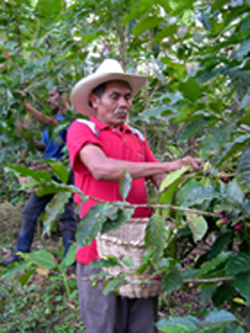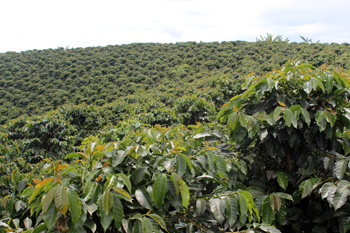Campus News
Proportion of shade-grown coffee shrinks as overall cultivation grows
While the cultivation of coffee has increased globally, the proportion of shade-grown coffee has fallen by nearly 20 percent since 1996, according to a study published in the May 5th issue of the journal BioScience.



While the cultivation of coffee has increased globally, the proportion of shade-grown coffee has fallen by nearly 20 percent since 1996, according to a study published in the May 5th issue of the journal BioScience.
The study’s authors, including Stacy Philpott, UC Santa Cruz associate professor of environmental studies, say the global shift toward a more intensive style of coffee farming is probably having a negative effect on the environment, communities, and individual farmers.
“The paradox is that there is greater public interest than ever in environmentally friendly coffee, but where coffee production is expanding across the globe, it tends to be very intensive,” said lead author Shalene Jha, assistant professor at the University of Texas at Austin.
In the report, “Shade Coffee: Update on a Disappearing Refuge for Biodiversity,” the researchers write that total global production of shade-grown coffee has increased since 1996, but the amount of land used for non-shade coffee has increased at a much faster rate, resulting in shade-grown coffee falling from 43 percent of total cultivated area to 24 percent.
Coffee’s changing face
“We demonstrate that the face of coffee is changing in different ways,” said Philpott, who holds the Heller chair in Agroecology at UCSC. “Although we see that there is more presence of shade-marketed and shade-certified coffees in the U.S. than we saw in 1990, there is actually a smaller fraction of coffee production area that is dedicated to diverse shade production.”
“The implications are significant,” Philpott said, “as we also show that ecosystem services, such as predation services, pollination, and climate adaptation are better provided in diverse shade production than in systems with less shade.” If the trend continues, she said, “coffee farms may begin to rely even more on non-natural inputs such as pesticides and fertilizers.”
Additional co-authors include two who earned their Ph.D.s at UCSC, Christopher Bacon, now at Santa Clara University, and V. Ernesto Méndez, at the University of Vermont.
Diverse canopy
Traditional shade-grown coffee is cultivated under a diverse canopy of native forest trees in dense to moderate shade. Though some forest understory is cleared for farming, a rich web of plant and animal life remains. Shade grown coffee plantations provide corridors for migrating birds, attract and support economically valuable pollinators such as bees and bats, and provide ecosystem services such as filtering water and air, stabilizing soil during heavy rains, storing carbon, and replenishing soil nutrients.
In the United States, the market for specialty coffee, which includes organic and shade-grown varieties, has grown rapidly during the past decade. Across most U.S. distributors, sales of specialty coffee rose more than 75 percent by economic value from 2000 to 2008. In 2012, specialty coffees accounted for 37 percent of U.S. coffee sales by volume and nearly half by economic value, an estimated $30 billion to $32 billion.
The study also found that since 1990, the land area under coffee cultivation has contracted in Africa and expanded in Asia. Most of the new production is done in an intensive style that is characterized by clearing forests or pasture for cultivation, increasing the density of plantings, and switching to a variety of coffee called Robusta that tolerates full sun. Robusta is a lower-quality coffee than the other major variety sold around the world, Arabica. The two strains are often blended to produce instant coffee.
Quest for profits
Jha and colleagues say the shifting trends toward Asia and a more intensive style of farming are driven by a dramatic drop in global coffee prices. To remain profitable, some growers have moved, seeking lower land and labor costs and higher short-term yields.
But there are hidden costs to this more intensive style. Full sun coffee plantations often result in deforestation, loss of biodiversity, and soil depletion while leaving communities more vulnerable to flooding and landslides.
Because the up-front costs of getting certified to sell specialty coffees can be expensive, Jha and colleagues encourage government agencies, conservation groups and aid organizations to partner with farmers to develop strategies to get more farmers into shade-grown coffee production.
Other co-authors are Peter Läderach, International Center for Tropical Agriculture, Nicaragua, and Robert Rice, Migratory Bird Center at the Smithsonian Conservation Biology Institute.